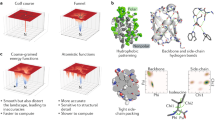Abstract
Computational grafting of target residues onto existing protein scaffolds is a powerful method for the design of proteins with novel function. In the grafting method side chain mutations are introduced into a preexisting protein scaffold to recreate a target functional motif. The success of this approach relies on two primary criteria: (1) the availability of compatible structural scaffolds, and (2) the introduction of mutations that do not affect the protein structure or stability. To identify compatible structural motifs we use the Erebus webserver, to search the protein data bank (PDB) for user-defined structural scaffolds. To identify potential design mutations we use the Eris webserver, which accurately predicts changes in protein stability resulting from mutations. Mutations that increase the protein stability are more likely to maintain the protein structure and therefore produce the desired function. Together these tools provide effective methods for identifying existing templates and guiding further design experiments. The software tools for scaffold searching and design are available at http://dokhlab.org.
Access this chapter
Tax calculation will be finalised at checkout
Purchases are for personal use only
Similar content being viewed by others
References
Mandell DJ, Kortemme T (2009) Computer-aided design of functional protein interactions. Nat Chem Biol 5(11):797–807. doi:10.1038/nchembio.251
Martin L, Stricher F, Misse D, Sironi F, Pugniere M, Barthe P, Prado-Gotor R, Freulon I, Magne X, Roumestand C, Menez A, Lusso P, Veas F, Vita C (2003) Rational design of a CD4 mimic that inhibits HIV-1 entry and exposes cryptic neutralization epitopes. Nat Biotechnol 21(1):71–76. doi:10.1038/nbt768
Tinberg CE, Khare SD, Dou J, Doyle L, Nelson JW, Schena A, Jankowski W, Kalodimos CG, Johnsson K, Stoddard BL, Baker D (2013) Computational design of ligand-binding proteins with high affinity and selectivity. Nature 501(7466):212–216. doi:10.1038/nature12443
Schulze H, Vorlova S, Villatte F, Bachmann TT, Schmid RD (2003) Design of acetylcholinesterases for biosensor applications. Biosens Bioelectron 18(2-3):201–209
Sia SK, Kim PS (2003) Protein grafting of an HIV-1-inhibiting epitope. Proc Natl Acad Sci U S A 100(17):9756–9761. doi:10.1073/pnas.1733910100
Hao J, Serohijos AW, Newton G, Tassone G, Wang Z, Sgroi DC, Dokholyan NV, Basilion JP (2008) Identification and rational redesign of peptide ligands to CRIP1, a novel biomarker for cancers. PLoS Comput Biol 4(8), e1000138. doi:10.1371/journal.pcbi.1000138
Rothlisberger D, Khersonsky O, Wollacott AM, Jiang L, DeChancie J, Betker J, Gallaher JL, Althoff EA, Zanghellini A, Dym O, Albeck S, Houk KN, Tawfik DS, Baker D (2008) Kemp elimination catalysts by computational enzyme design. Nature 453(7192):190–195. doi:10.1038/nature06879
Drakopoulou E, Zinn-Justin S, Guenneugues M, Gilqin B, Menez A, Vita C (1996) Changing the structural context of a functional beta-hairpin. Synthesis and characterization of a chimera containing the curaremimetic loop of a snake toxin in the scorpion alpha/beta scaffold. J Biol Chem 271(20):11979–11987
Azoitei ML, Correia BE, Ban YE, Carrico C, Kalyuzhniy O, Chen L, Schroeter A, Huang PS, McLellan JS, Kwong PD, Baker D, Strong RK, Schief WR (2011) Computation-guided backbone grafting of a discontinuous motif onto a protein scaffold. Science 334(6054):373–376. doi:10.1126/science.1209368
Hearst DP, Cohen FE (1994) GRAFTER: a computational aid for the design of novel proteins. Protein Eng 7(12):1411–1421
Zhang J, Grigoryan G (2013) Mining tertiary structural motifs for assessment of designability. Methods Enzymol 523:21–40. doi:10.1016/B978-0-12-394292-0.00002-3
Shirvanyants D, Alexandrova AN, Dokholyan NV (2011) Rigid substructure search. Bioinformatics 27(9):1327–1329. doi:10.1093/bioinformatics/btr129
Yin S, Ding F, Dokholyan NV (2007) Eris: an automated estimator of protein stability. Nat Methods 4(6):466–467. doi:10.1038/nmeth0607-466
Berman HM, Westbrook J, Feng Z, Gilliland G, Bhat TN, Weissig H, Shindyalov IN, Bourne PE (2000) The Protein Data Bank. Nucleic Acids Res 28(1):235–242
Hooft RW, Vriend G, Sander C, Abola EE (1996) Errors in protein structures. Nature 381(6580):272. doi:10.1038/381272a0
Ramachandran S, Kota P, Ding F, Dokholyan NV (2011) Automated minimization of steric clashes in protein structures. Proteins 79(1):261–270. doi:10.1002/prot.22879
Ding F, Tsao D, Nie H, Dokholyan NV (2008) Ab initio folding of proteins with all-atom discrete molecular dynamics. Structure 16(7):1010–1018. doi:10.1016/j.str.2008.03.013
Dokholyan NV, Buldyrev SV, Stanley HE, Shakhnovich EI (1998) Discrete molecular dynamics studies of the folding of a protein-like model. Fold Des 3(6):577–587. doi:10.1016/S1359-0278(98)00072-8
Ding F, Dokholyan NV (2006) Emergence of protein fold families through rational design. PLoS Comput Biol 2(7), e85. doi:10.1371/journal.pcbi.0020085
Yin S, Ding F, Dokholyan NV (2007) Modeling backbone flexibility improves protein stability estimation. Structure 15(12):1567–1576. doi:10.1016/j.str.2007.09.024
The PyMOL Molecular Graphics System, Version 1.7.4 Schrödinger, LLC
Acknowledgment
This work was supported by National Institutes of Health Awards R01GM080742 and R01AI102732.
Author information
Authors and Affiliations
Corresponding author
Editor information
Editors and Affiliations
Rights and permissions
Copyright information
© 2017 Springer Science+Business Media New York
About this protocol
Cite this protocol
Zhu, C., Mowrey, D.D., Dokholyan, N.V. (2017). Computational Protein Design Through Grafting and Stabilization. In: Samish, I. (eds) Computational Protein Design. Methods in Molecular Biology, vol 1529. Humana Press, New York, NY. https://doi.org/10.1007/978-1-4939-6637-0_11
Download citation
DOI: https://doi.org/10.1007/978-1-4939-6637-0_11
Published:
Publisher Name: Humana Press, New York, NY
Print ISBN: 978-1-4939-6635-6
Online ISBN: 978-1-4939-6637-0
eBook Packages: Springer Protocols




